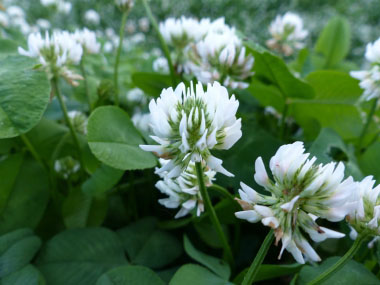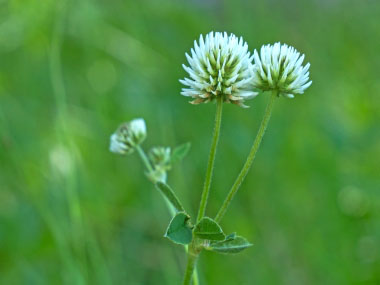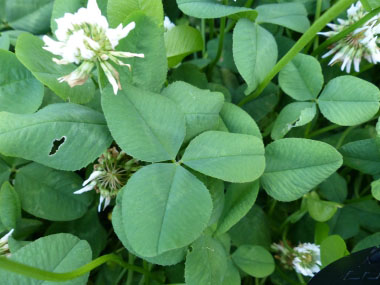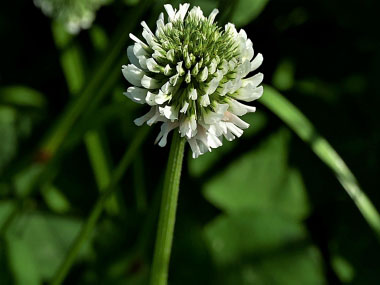






To support our efforts please browse our store (books with health benefits, etc.).
White clover is a perennial plant in the pea family (Fabaceae). It spreads by stolons (runners) and forms shallow roots at nodes. Adapted to soils with fine to medium texture, they can survive in well to poorly drained areas. White clovers tolerate acid to moderately alkaline conditions. Although this plant has a low tolerance to heat and drought, is can tolerate flooding and is very winter hardy. White clover is native to Europe and parts of Asia.
Distinguishing Features
This creeping perennial plant has compound leaves formed from three leaflets. It can be found from mid-spring through the summer, and into early autumn if it has enough water through the drier summer months. The white flowers are easy to spot as well as the leaves.
Flowers
Flowers can bloom any time from May through to September (in the northern hemisphere). Flowers are white, and as they age they are brownish. They measure 8 to 10 mm long, fused at base. They have 5 petals. The calyx is 5-lobed, and glabrous. There are 10 stamens and a single carpel. Inflorescence a long-stalked, densely globose head, and the flowers are fragrant.
 Fields
of Nutrition has medicinal benefits and vitamin/mineral content of White Clover.
Fields
of Nutrition has medicinal benefits and vitamin/mineral content of White Clover.
Leaves
The leaves are formed from three elliptic shaped leaflets.Leaves occur alternate, long-stalked, and stipulate. Each leaflet is obovate–obcordate, with finely toothed margins, sometimes with white patterning. On very rare occasions, a four-leafed clover can occur.
Height
White clover can grow 10 to 30 cm (4 to 12”) tall.
Habitat
This plant can grow in meadows, lawns, yards, paths, waste ground, roadsides, and even along shores. White clover grows throughout Canada and the U.S. as well as Europe, Asia, parts of South America, Australia and New Zealand.
Edible Parts
All aerial parts, including the seeds, are edible. However, it is highly advised if you have never eaten these before to start with a very small quantity. Clovers can cause mild or severe gas.
Other Name
Dutch Clover.
Similar Plants
Winter Survival Food Handbook

PDF Plant Magazines
Types of Wild Food
Geographic Zones Seasons
Disclaimer
EdibleWildFood.com is informational in nature. While we strive to be 100% accurate, it is solely up to the reader to ensure proper plant identification. Some wild plants are poisonous or can have serious adverse health effects.
We are not health professionals, medical doctors, nor are we nutritionists. It is up to the reader to verify nutritional information and health benefits with qualified professionals for all edible plants listed in this web site. Please click here for more information.
Why Edible Wild Food?
- Food costs are rising
- Free, wild food is readily abundant
- Wild food adds nutrition to your diet
- Wild food can help treat various medical conditions





